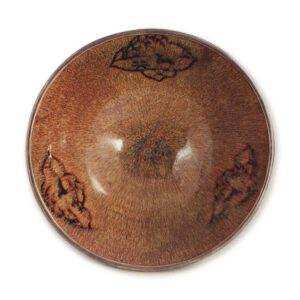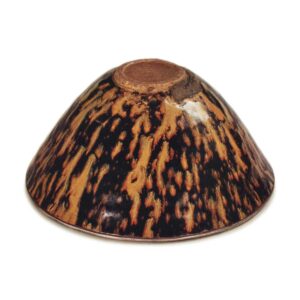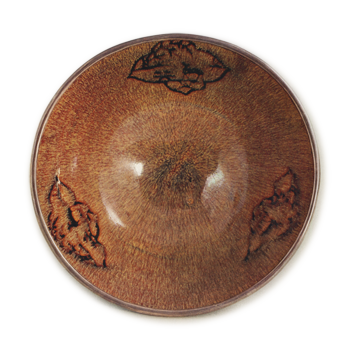

Daimeibutsu
Tokugawa Art Museum
Height: 7.8 – 8.1 cm
Diameter: 17.0 – 17.3 cm
Outer diameter of foot ring: 4.5 cm
Height of foot ring: 0.4 cm
This is a very large Tenmoku tea bowl, which is closer to a bowl than a tea bowl. The walls of the bowl are thick, and it feels heavy in the hand, so it may seem strange to those who are used to thin, light tea bowls. However, everything is large, so it may be good for looking at the technique.
The clay is the white, rough clay characteristic of the Kishu kilns, and as usual, the foot ring is low. However, the foot ring has a horizontal scrape at the edge, and the inside of the foot ring is also slightly scraped, so it is clear that this is a work of the same type as the Tenmoku ware of the Kenmoku kilns. Of course, the clay is visible only on the foot ring, and the rest of the piece is covered in glaze. The glaze is applied in a pattern that is open on the inside and covered on the outside, in the so-called “rough skin lid-through” style.
The glaze is applied in a double layer, which is characteristic of Tenmoku ware. Looking at the inside, a dark iron-based underglaze is applied to the entire surface, and then three pieces of patterned paper are attached to the glaze. Then, a water glaze with a high silica content is applied and fired. The parts with the paper attached are fired in the kiln so that the paper burns off and only the underglaze remains, so the black color of the underglaze does not change. In the other parts, the underglaze melts into the overglaze and turns a caramel color, and the iron crystals flow in streaks. In other words, the rabbit’s fur is created. In this way, the black pattern emerges on the amber-colored background.
The pattern on this tea bowl is particularly unusual among the many taiha-gai patterns, and depicts a kind of landscape-like motif, such as a deer playing under a tree, within a square frame. The patterns on the tea bowls are usually decorative, so this kind of descriptive composition is extremely rare. Of the three patterns, one is clearly visible, but the other two are blurred slightly due to the glaze running and bleeding. The glaze on this tea bowl appears to contain straw ashes, and the surface is covered with a pattern of streaks and spots. The exterior of the bowl is also covered with a glaze containing a high concentration of iron, and the top glaze is applied in a dripping manner, rather than being applied evenly over the entire surface. The irregularly scattered glaze on the surface melted and flowed together with the underglaze during firing, resulting in a yellowish-brown flow appearing on the black glaze. While it looks like a naturally occurring glaze pattern, it was actually created using a detailed technique. There is almost none on the outside, but the inside of the cup has a slightly iridescent glaze surface.
This tea bowl has been in the possession of the Owari Tokugawa family since ancient times, and in old records it is referred to as the “Nemihiga-Ukaigawan”, and it seems that it was originally used for serving sake. Considering that it belonged to the so-called “Hatsune no Chodo” of Chiyohime (the eldest daughter of Iemitsu Shogun and the wife of Mitsutomo, the second Owari lord), it is thought that it was originally owned by the Yanagi clan.



